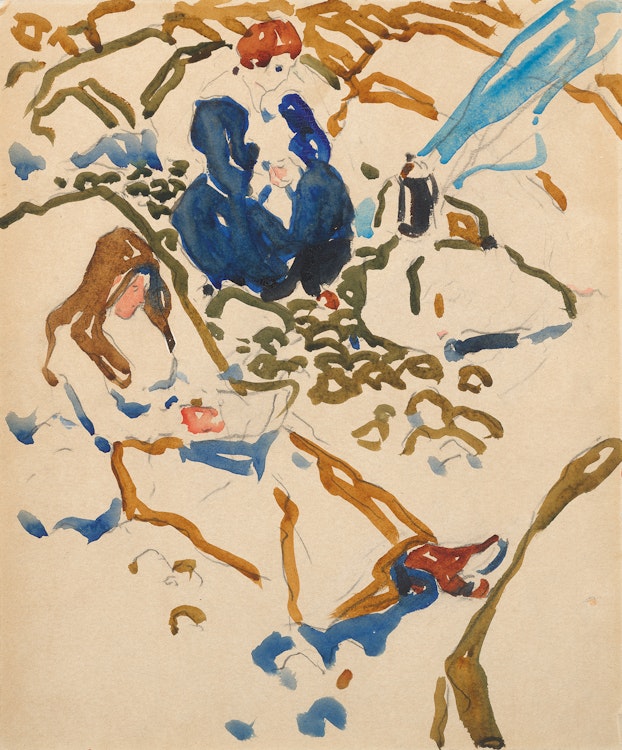Picnic by David Brown Milne

David Milne
Picnic
watercolour on illustration board
catalogue raisonné no. 105.11
12 x 10 ins ( 30.5 x 25.4 cms )
Auction Estimate: $20,000.00 - $25,000.00
Price Realized $33,600.00
Sale date: June 9th 2021
Estate of the artist
Private Collection, Toronto
David Milne Jr. and David P. Silcox, David B. Milne: Catalogue Raisonné of the Paintings, Volume 1: 1929-1953, Toronto, 1998, listed and reproduced page 99 (no. 105.11)
Katherine Lochman (ed.), David Milne: Watercolours, Art Gallery of Ontario, Toronto, 2005, pages 21, 24, 41 and 44
The New York Times heralded Milne’s works as “conventional subject, unconventional style” and noted that “Mr. Milne has made himself a master of the art of patterning and builds up his blocks of colour as precisely as the modern doctor diagrams your heart...Whatever he may have to say you feel that he makes no mistake in the form of his statement.” Carol Troyen concurs: “Milne used watercolour for many of his greatest innovations. He associated it with directness, clarity, and independent expression—in short, with modernism.”
Milne’s distinct and self-assured approach in watercolour is evident in “Picnic”. Completed “circa” 1913, the work bears the quintessential hallmarks of the artist’s oeuvre, including generous open space, rich opaque strokes of striking cobalt and rust, and a nod to master Modern artists like Paul Cézanne and Henri Matisse. The catalogue raisonné for Milne notes that this work depicts Patsy, the wife of the artist. Patsy figured prominently in many of Milne’s figurative works - often portrayed in a moment of leisure. Casually seated on the lawn with her companion, Patsy’s fiery red hair is distinctive in “Picnic”. Milne’s use of the exposed support allows the work to breathe organically, mirroring the calm ease of lunching on the grass. Vibrant strokes of sapphire, cerulean, olive and ochre break free of the pencil outlines to add energy to the scene and imbue the work with intention. Milne described his watercolour practice as “so direct, so powerful, even brutal...it should be the painting medium because it is faster, and painting is the instantaneous art.”
Share this item with your friends
David Brown Milne
(1882 - 1953) Canadian Group of Painters
Milne was born near Paisley, Ontario. A childhood interest in art, which revived while he was teaching, led him to take a correspondence course and eventually he travelled to New York City to continue his studies. This was somewhat of an exception in the early twentieth-century Canadian art scene as the majority of artists went to Europe to study. While in New York City, Milne worked as a commercial illustrator for several years before deciding to give up this work and devote his time to painting. Shortly after making this decision he moved to Boston Corners in New York.
Throughout his life Milne sought the peace and solitude of a rural life. In his paintings, Milne explored different viewpoints. He greatly admired the work of Tom Thomson but had little interest in the nationalistic approach of the Group of Seven. His themes range from landscapes to views of towns and cities, still lifes and imaginary subjects. His experiments with different media and changing viewpoints show his interest in the process of painting itself. In 1929, Milne returned to settle permanently in Canada, stopping for brief periods in Temagami, Weston, and Palgrave. He built a secluded cabin at Six Mile Lake, north of Orillia, and spent the next six years painting, for the most part, alone. Milne was interested in 'pure' painting, in "adventures in shape, colour, texture and space" as he called his watercolours of the 1930s and 1940s. The change from the less vibrant drybrush "adventures" to the fantasy watercolours is often attributed to the birth of his only child, David Jr., born to Milne's second wife when Milne was sixty. His young son encouraged him to adopt a new, vibrant and often whimsical approach to his art. Milne spent the rest of his life in Uxbridge, north of Toronto, exploring the Haliburton and Bancroft areas as well as the city of Toronto.

